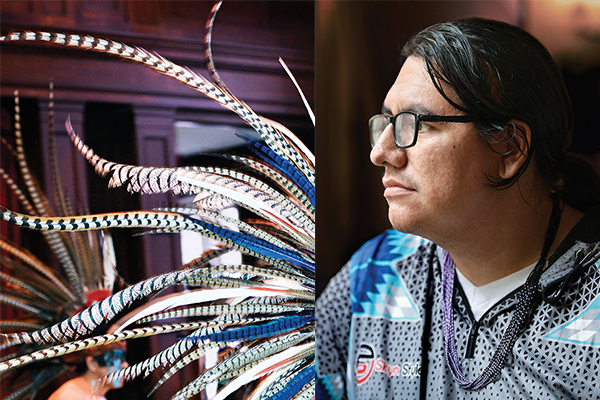When the drumming stops and the dancers sit, Talon Bazille Ducheneaux takes the microphone. He speaks slowly, powerfully. “I just wanted to say I’m really appreciative and proud and honored to be a part of this community,” he says, looking around at the people gathered inside Houston Hall for the 10th annual powwow put on by Natives at Penn (NAP), the University’s student group for Native Americans celebrating its 25th anniversary.
The crowd, filled with traveling Native American drum groups and dancers from tribes around the region, looks larger than it did seven years ago when—then a Penn freshman—Ducheneaux was asked to emcee the powwow with just two days’ notice. He wasn’t given a schedule for the event, which was then held outdoors. It was cold. And rainy. And sparsely attended. A much different affair than this year’s crowded powwow, which lasted almost seven hours on March 31 and was modeled more closely on the traditional social gatherings Native Americans hold to honor their cultures. “Seeing you all and seeing where this powwow is,” he says, “it’s amazing that it’s been 10 years. There seems to be continuity and structure and validity to what we’re doing.”
Continuity and structure are two things Ducheneaux didn’t have for much of his life, and validity is something he’s always chased. Growing up on two reservations in South Dakota (Cheyenne River and Crow Creek), he says he “witnessed the best part of Native success and the worst parts of its destruction.” His parents were “big into drugs and alcohol” and moved around a lot before divorcing. Friends suffered from addiction too. He had to travel a good hour just to buy groceries at the nearest Walmart. The opportunity to leave the reservation for an Ivy League school made him feel like “almost a celebrity,” with some people telling him how awesome it was but others giving off an Oh-he-thinks-he’s-better-than-us vibe. “Coming to Penn, I had an opportunity to figure out for four years: Who am I? What am I doing? What do I want to represent?” After first making the 1,500-mile journey to Philly in his red Mazda, he tried to lay low. But it didn’t take long for him to realize that if he wanted Native Americans to gain more validity on college campuses, he had to represent everything: his people, his family, his tribe, his home. “It’s a lot of unfair responsibility they put on us at 18,” he sighs.
After hooking on with NAP and finding “a second home” at the Greenfield Intercultural Center, where the group is housed, he met several other Penn students with Native backgrounds, from different tribes and parts of the country. Learning about each other’s identities proved to be eye-opening for him—as it was for others. “You don’t have to look a certain way to be Native,” explains Jules Crain who admits that her ancestors’ heritage “wasn’t a huge part of my life” before NAP invited her to a welcome dinner her first week at Penn. “And now,” she says, “I’m texting everyone saying, ‘Come to powwow!’”
Read more at The Pennsylvania Gazette.








